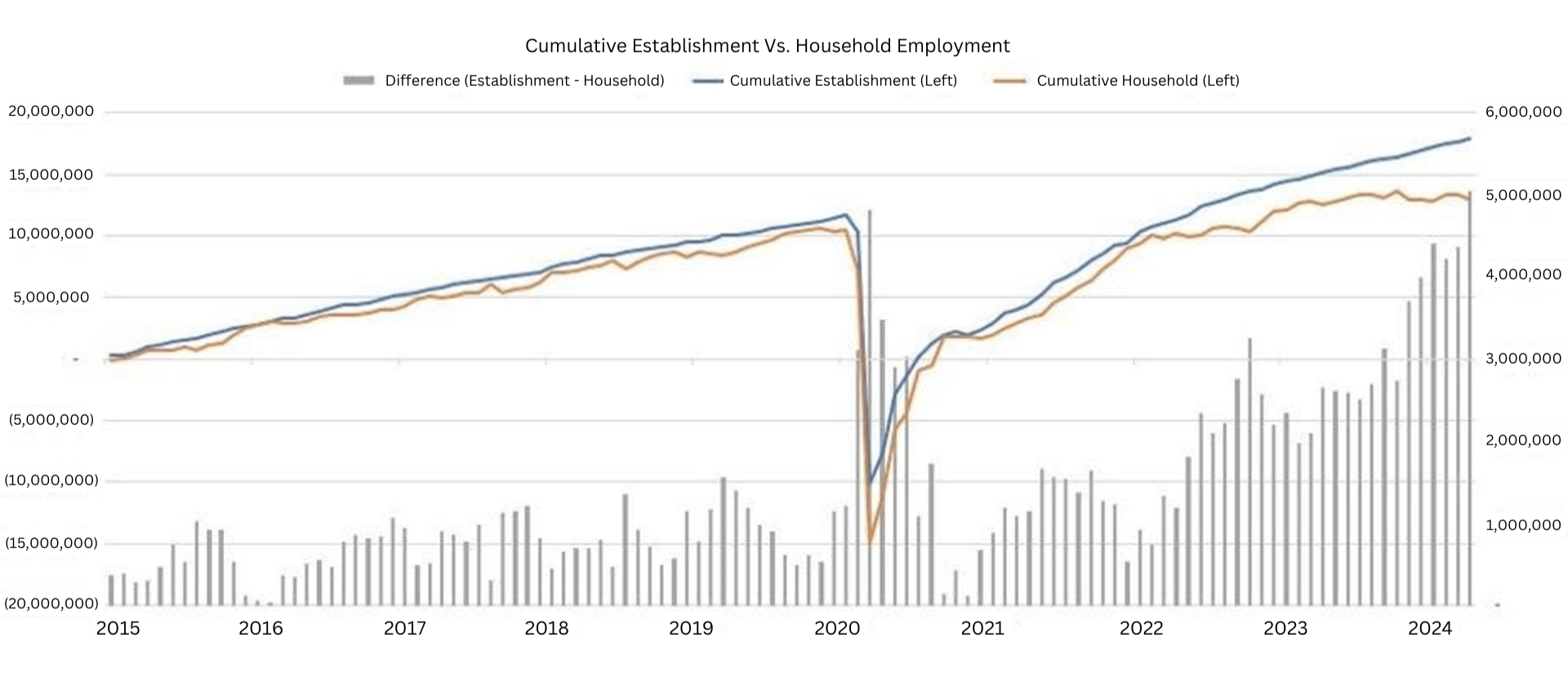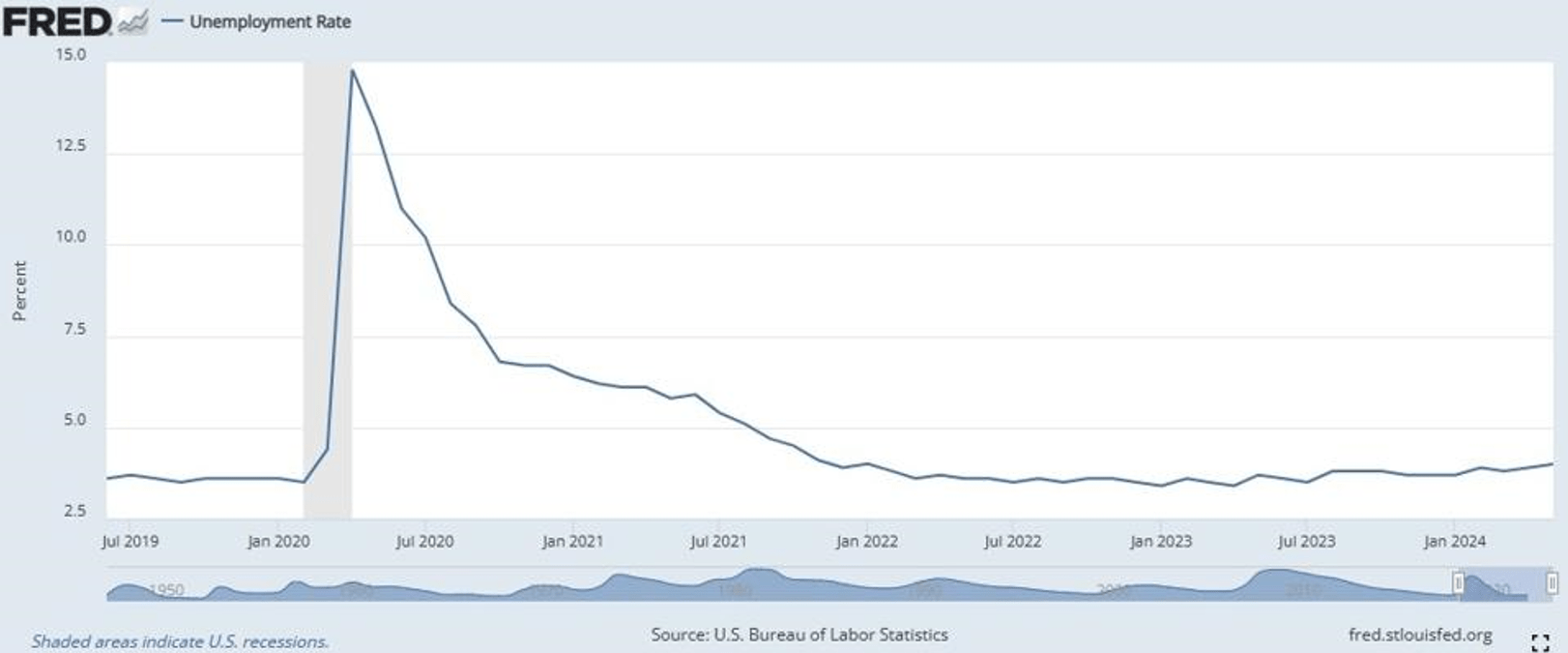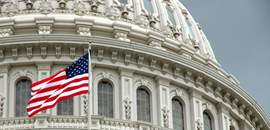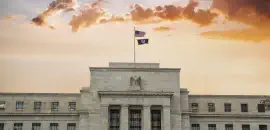Strong Payroll Gains Exceed Expectations
The 272,000 jobs added to nonfarm payrolls in May far exceeded investors’ expectations, continuing a pattern of strong gains over the past 12 months from the Bureau of Labor Statistics’ employment survey. During that span, nonfarm payrolls have increased on average by 230,000 per month.
This pace far exceeds what most economists assume to be steady-state nonfarm payroll growth at about 100,000 jobs. This figure was the pace of hiring between the business cycle peaks of 2007 and 2020, and it also matches the growth of the working-age population.
Mixed Signals From Different Surveys
Accordingly, many investors now question whether the Federal Reserve will lower interest rates in the balance of this year. However, the whole story of what is happening in the labor market is complex because other indicators paint a different picture.
For example, employment measured by the BLS’ household survey fell by 408,000 in May. This survey, which counts the number of people employed, shows jobs have increased by an average of only 30,000 per month over the past 12 months.
As shown in the chart below, the two measurements of employment are in sync much of the time, but there has been a growing disparity between them over the past couple of years.
Employment Measures: BLS Payroll Vs. Household Surveys
 Source: Cumulative vs. Household | FRED
Source: Cumulative vs. Household | FRED
Understanding the Disparity
So, what accounts for this disparity, and does it matter to the Fed?
Jim Glassman, an economist formerly with JPMorgan Chase who monitored the Fed, explains the differences in a recent memorandum for his clients. The BLS payroll survey is the most commonly cited jobs measure because it covers 666,000 workers and is less volatile compared with the household survey, which covers 60,000 households. BLS estimates of jobs associated with business startups and failures are based on a birth-death model, which then gets recalibrated in annual benchmark revisions.
One difference between the two measures is that the household survey includes domestic work and self-employed, including workers who are paid off the books.
Another difference is that people who work multiple jobs may be counted more than once in the BLS survey. This is an important factor contributing to the widening disparity in the two reports because moonlighting — which means holding multiple jobs — has rebounded in the past few years after it weakened during the pandemic, per FRED, which shows up in the data as an acceleration in the number of gig workers and a slowdown in the number of full-time workers.
Economists also suspect that increased immigration might be boosting nonfarm payrolls, but it is difficult to know the magnitude. The wild card is the impact of undocumented immigrants. Don Luskin of Trend Macro recently contended in a Wall Street Journal opinion piece that this is the main source of increased job growth.
Other Employment Indicators
Finally, another consideration is that estimates of private-sector employment by the BLS and the ADP typically agree on broad trends: Both datasets show private-sector payrolls have increased by about 200,000 per month over the past year and a half.
Looking at these considerations, Glassman does not believe the disparate employment trends are a conundrum for the Fed. He observes:
"No one knows what the optimal pace of hiring is, given the unknowns about immigration and moonlighting. That’s why the Fed’s annual statement of its goals includes no numerical goal for the pace of job growth consistent with the maximum employment mandate. Bottom line: "maximum employment" is best characterized by unemployment."
Unemployment Trends
The picture of the job market comes into clearer focus when one looks at the trend in the unemployment rate: It has been creeping up for a year now and did so again in May when it approached 4% for the first time in two years despite strong growth of nonfarm payrolls.
Unemployment Rate: July 2019 to May 2024
 Sources: Unemployment Rate | FRED
Sources: Unemployment Rate | FRED
Requests for unemployment insurance benefits have also been turning up marginally, The Associated Press reported in April. This information tracks people who already are in the job market, have had a job, and have credits with the unemployment insurance system. The data is monitored closely because they are timely (reported with a one-week lag) and based on actual counts rather than surveys.
Job Market Softening
Additional evidence about the jobs market softening comes from the Job Opening and Labor Turnover Survey report. Job openings fell more than expected in April and pushed the number of available jobs per jobseeker to its lowest level in nearly three years. The ratio of openings for unemployed workers declined to 1.24 in April. It is now well below its post pandemic peak of nearly 2-to-1 and is closely watched by Fed Chair Jerome Powell as a measure of labor market tightness.
Fed's Interest Rate Decision
A version of this article was posted to Forbes.com on June 10, 2024.



























